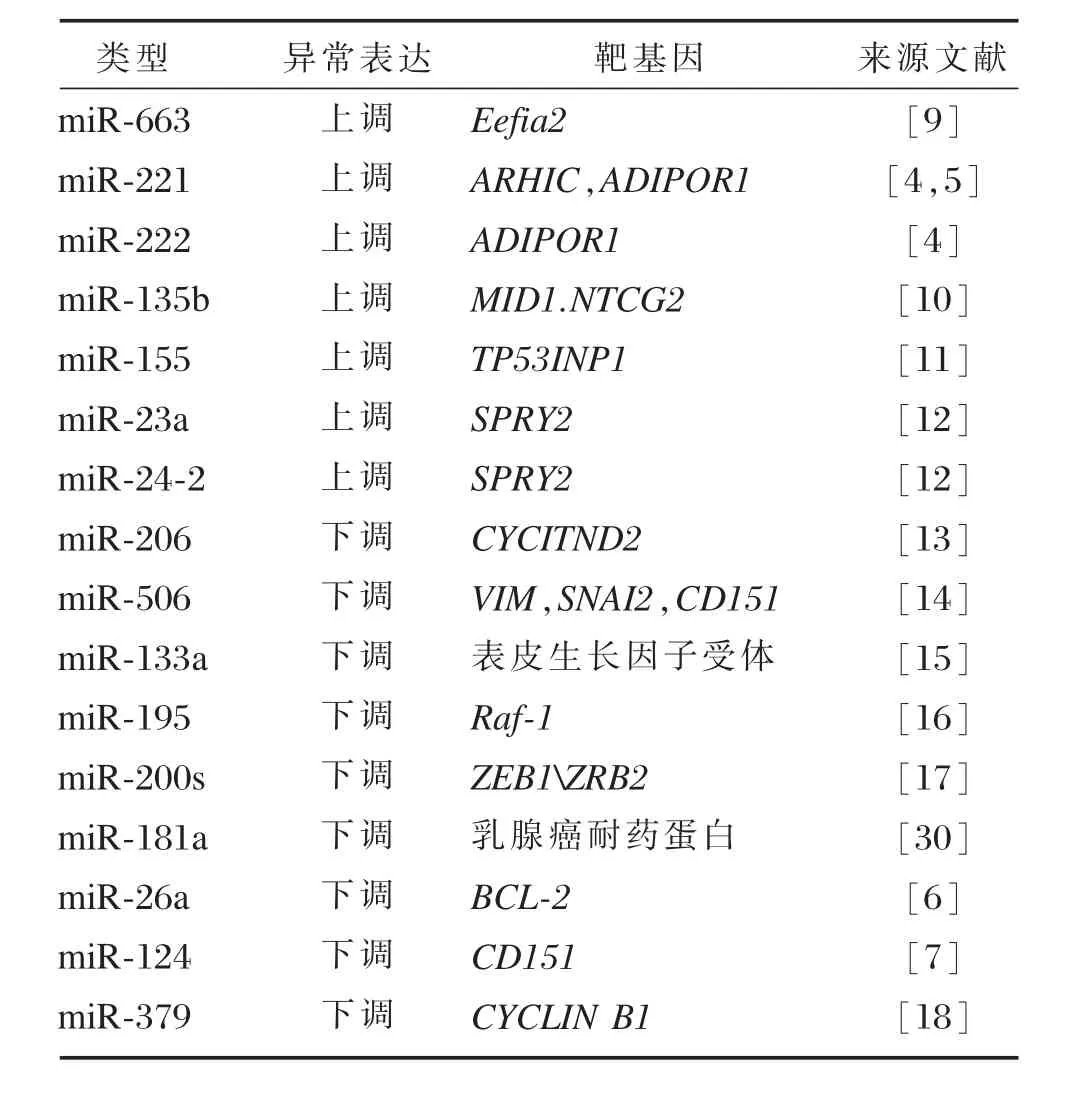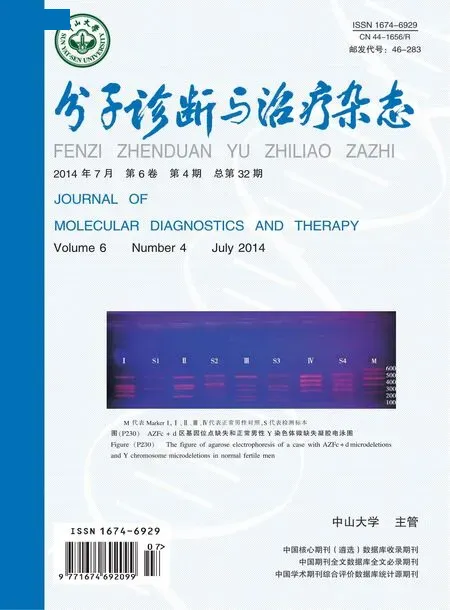miRNA在乳腺癌中作用的初步研究状况
2014-03-03周桃玉综述温旺荣审校
周桃玉 综述 温旺荣审校
·综述·
miRNA在乳腺癌中作用的初步研究状况
周桃玉 综述 温旺荣★审校
乳腺癌是女性最常见的恶性肿瘤。近年来,其发病率在全球范围内呈增长趋势。虽然有关乳腺癌的研究较多,并取得一定成果,但是该肿瘤的侵袭和转移机制仍然未彻底阐明。最近有研究发现miRNA的异常表达与乳腺癌的发生发展密切相关,且具有一定的临床应用价值。现就miRNA对乳腺癌发生发展、诊断、治疗和预后相关研究作一综述。
乳腺癌;微小RNA
微小核糖核酸(microRNA、miRNA)是一类广泛存在于真核细胞中的高度保守的内源性小分子RNA,大小在18~25个核苷酸之间。它并不编码蛋白质而是通过与特定靶基因mRNA的3’端非翻译区(3’-untranslated region,3’-UTR)序列互补配对,调节编码蛋白质的mRNA分子,抑制其翻译,或导致其降解。这种通过miRNA介导的转录后基因沉默,与乳腺癌的发生发展密切相关。目前对有关乳腺癌发生发展、诊断、治疗和预后的miRNA作了不少研究,特异性miRNA将有望用于临床。
1 miRNA在乳腺癌发生发展中的作用
miRNA作为一类非蛋白质编码的RNA分子,参与了基因表达转录后水平负调控作用。miRNA中的核苷酸多态性(single nucleotide polymorphism,SNP)与肿瘤的易感性密切相关。在我国,miR-499rs746444位点A>G多态性,使乳腺癌风险显著增加,已成为中国女性人群的独特风险因子,是中国女性乳腺癌的易感性的重要原因[1]。
乳腺癌的发生也与人类的生活方式有关。Shi等[2]报道,乳腺癌发生的一个重要诱因可能是长期夜班轮班工作使得miR-219DNA甲基化异常,降低miR-219的表达,使免疫介导的抗肿瘤活动下调,从而增加了乳腺癌发生的风险。
miRNA有类似于癌基因或抑癌基因的功能,广泛参与调控肿瘤细胞的增殖、分化、凋亡、代谢、侵袭及转移等过程。Anaya-Ruiz等[3]通过用miR-153抑制剂转染MDA-MB-231乳腺癌细胞,发现miR-153的沉默可抑制细胞生长,说明miR-153在乳腺癌细胞中的过度表达有可能与乳腺癌的发生有关。miR-221/222可通过与ADIPOR1(一种脂肪细胞因子脂联素受体)mRNA3’-UTR结合,增加ADIPOR1的消耗,ADIPOR1的减少能活化NF-kB进而使信号传感器和转录激活因子磷酸化,促使上皮细胞向间质细胞的转变(epithelial-to-mesenchymal transition,MET),促进肿瘤细胞的浸润和转移[4]。也有研究表明,miR-221还可通过作用于靶基因ARHI(一种抑癌基因其可以抑制细胞增殖,侵袭及诱使细胞凋亡)的mRNA 3’-UTR而抑制ARHI基因的表达下调导致肿瘤发生[5]。miR-26a可通过抑制MCL-1(一种抗凋亡BCL-2的家族成员)来抑制乳腺癌细胞的增殖和转移[6]。miR-124可作用于CD151的mRNA 3’-UTR,抑制CD151mRNA的表达和翻译,抑制肿瘤细胞的增殖及其转移,从而发挥其抑癌作用[7]。miR-374a具有调节血管密度分布的功能,可以通过增加乳腺癌组织中的血管密度来增加乳腺癌细胞的的侵袭、浸润和转移,具有致癌作用[8]。
2 乳腺癌密切相关miRNA表达谱
目前已有一些有关乳腺癌相关miRNA表达异常及其功能研究的报道,主要涉及表达异常乳腺癌相关miRNA的相关信息见表1。
3 乳腺癌相关miRNA的临床应用研究
miRNA具有不易被RNA酶、煮沸、反复冻融、酸和长期保存等因素降解或破坏,在血清中高度稳定,部分miRNA在乳腺癌患者血清中表达异常,且在血清中检测miRNA方便、快捷、创伤性小等优点[19]。因此,血清中检测miRNA可用于乳腺癌早期诊断,治疗监测和预后判断。

表1 乳腺癌主要相关miRNA的表达谱及其靶基因Table1The spectrum and target genes of the miRNA associated with breast cancer
3.1可能作为肿瘤标志物监测乳腺癌
Bisso等[20]发现从正常组织到乳腺癌的一期,二期,三期的发展过程中miR-181a/b的表达水平会随之增高;与肿瘤一期相比,在三期乳腺癌组织中约70%检测到高表达水平的miR-181a和miR-181b,同时还发现在5年内发生转移的原位乳腺癌中的miR-181b表达过度,而在无转移的原位癌中表达却极低。有研究表明如联合使用在乳腺癌组织中异常表达的miR-125b/miR-191可能预测乳腺癌的存在,且其敏感性可达100%,特异性为94%;而联合使用miR-21/miR-191敏感性也能达92%,而特异性可达100%[21]。这些研究表明,miRNA可用于监测乳腺癌的发生发展,尤其是miRNA的联合检测。
3.2可用于良恶性乳腺肿瘤的鉴别
区别乳腺肿瘤的良恶性具有重要的临床意义。它是选择乳腺肿瘤治疗方法的先决条件,关系着患者的治疗效果和预后的重要问题。近来有研究表明某些miRNA在良性乳腺肿瘤、恶性乳腺癌及正常乳腺组织中表达不同,提示miRNA有可能用于鉴别乳腺肿瘤的良恶性。如Tang等[22]研究了miR-1258和乙酰肝素酶(heparanase,HPSE)在良恶性乳腺癌及正常乳腺组织中的表达水平,发现miR-1258在有淋巴结转移的冰冻乳腺癌组织中的表达水平远低于无淋巴结转移的乳腺癌组织中的表达水平,而乙酰肝素酶确在有淋巴结转移的乳腺癌中的表达水平高于无淋巴结转移的乳腺癌中的表达水平,两者成反比关系;在血清样本中miR-1258在M1期乳腺癌中的水平比M0期原位乳腺癌和良性乳腺疾病的水平低,而在M1期患者血清中的乙酰肝素酶则均高于M0期原位癌和良性疾病中的水平,说明miR-1258可能通过调控乙酰肝素酶的表达来调节乳腺癌的发生发展,并且说明miR-1258可能与乳腺癌的分期有关。Schwarzenbach等[23]通过比较102名术前乳腺癌患者、32名良性乳腺疾病的患者以及53名正常女性的miR-20a、miR-21和miR-214,发现前两者在良恶性肿瘤患者血清样本中的水平均高于正常女性;而miR-214在恶性乳腺癌患者中水平明显高于良性疾病,在术后乳腺癌患者血清样本中的miR-214水平要比术前乳腺癌血清样本中要低得多,且其表达水平的增加与淋巴结转移密切相关,因此miR-214可望作为区分良恶性乳腺肿瘤的新指标。
3.3可能用于鉴定乳腺癌亚型
能及时准确的鉴定出乳腺癌型别也是有效治疗乳腺癌的一项先决条件。因为一旦确定了乳腺癌亚型就可以针对病人治疗和预后作出正确的临床决策。近年来有研究报道在不同乳腺癌的亚型中miRNA表达不同,表明通过检测miRNA的表达水平有可能区分乳腺癌的亚型。
Lerebours等[24]通过运用实时定量PCR检测了12名炎性乳腺癌患者、31例未分期的非炎性乳腺癌的患者和8例正常乳腺样本血清中804种miRNA发现miR-421、miR-486、miR-503、miR-720、miR-1303在炎性乳腺癌中表达异常且可用来预测炎性乳腺癌,其预测的准确率达89%。有研究表明ERβ(雌激素受体)能促进乳腺癌细胞中的miR-23b、-27b和24-1增加,因此miR-23b、-27b和24-1等在ERβ+的乳腺癌中表达显著上调[25],预示着miR-23b、-27b和24-1与ERβ+的乳腺癌密切相关。miR-21与乳腺癌的发生发展密切相关,近来有研究报道miR-21在人类表皮生长因子受体2阳性乳腺癌中过度表达[26_27]。也有研究表明miR-200家族成员[28]、miR-93[29]异常表达也与乳腺癌的亚型有关。
3.4在乳腺癌治疗中的作用
3.4.1miRNA与多种抗肿瘤放疗药物疗效密切相关
Jiao等[30]采用微阵列分析比较了米托蒽醌耐药(mitoxantone-resista-nt,MX)的乳腺癌细胞株MCF-7/MX与其同系MX敏感株中能调控乳腺癌耐药蛋白(breast cancer resistance protein,BCRP)的miRNA的表达差异,发现MiR-181a在MCF-7/MX中明显下调;且在运用荧光素酶活性测定后的结果显示MiR-181a可靶向作用于BCRP mRNA的3’端非翻译区(UTR)抑制BCRP的表达;过度表达的MiR-181a能降低BCRP的表达且能使MCF-7米托蒽醌耐药细胞株向MCF-7米托蒽醌敏感株转变,从而增加乳腺癌细胞对米托蒽醌药物治疗的敏感性。Andrea Bisso等[20]也发现类似于致癌基因的miR-181a/b在乳腺癌中不仅可以负调控DNA损伤反应(DNA damage response,DDR)而且影响共济失调毛细血管扩张症的压力传感器激酶突变的表达和活性,且miR-181a/b的表达下调还能增加三阴乳腺癌细胞对PARP1抑制剂治疗的敏感性;通过比较miR-181a/b转染MDA-MB-231细胞和未转染的MDA-MB-231细胞在奥拉帕尼作用下的结果显示miR-181 a/b表达下调增加了肿瘤细胞对PARP1治疗的敏感性。也有研究表明has-miR-107和has-miR-222能通过抑制RAD51的表达调控DNA损伤反应(DDR)和肿瘤细胞对奥拉帕尼的敏感性,从而提高肿瘤细胞对PARP治疗的敏感性,提高PARP杀死肿瘤细胞的功能[31]。有研究结果显示miR-195的表达上调能增加乳腺癌细胞对阿霉素的敏感性[16]。预示着miRNA有可能成为筛选乳腺癌靶向治疗个体并作为实现个性治疗的新标志物。
3.4.2可能与抗肿瘤药物耐药有关
有效治疗乳腺癌的一大障碍是出现药物耐药,多项研究表明某些miRNA的异常表达与乳腺癌的药物耐药有关。表皮-间质细胞转变(EMT)被认为在药物抗性发挥重要作用[32]。而miR-125b能诱导乳腺癌细胞上皮间质细胞转变的细胞标记改变,使表皮细胞钙黏素标记明显下调,使间叶细胞神经钙黏素,玻形蛋白等标记上调,从而参与药物耐药;miR-125b还能通过调节SP(耐药干细胞群)细胞来调控药物耐药[33]。Zhi等[34]研究表明miR-21的异常表达与聚乙烯亚胺/聚4-苯乙烯磺酸钠/炭美石墨烯(PPG)多药耐药密切相关,miR-21上调能抑制抗癌药物的疗效。还有研究表明miR-200家族成员的表达下调能导致LY2人类乳腺癌抗雌激素耐药[35]。提示上述miRNA可能作为抗肿瘤药物耐药的监测指标。
3.5能用于评估乳腺癌的预后
miRNA的异常表达与乳腺癌的临床分期及淋巴结转移有关,具有乳腺癌预后评估功能。Li等[36]通过运用定量反转录聚合酶链反应来比较在不同临床分期的乳腺癌组织和相应正常临近乳腺组织中miR-206的表达结果显示:在有淋巴结转移及临床分期在Ⅲ期的乳腺癌组织中的miR-206含量明显低于临近正常组织,且运用单变量和多变量Cox比例风险回归分析发现miR-206过低的乳腺癌患者的总体生存时间短。表明miRNA有可能用于乳腺癌预后评估的一个新指标。
4 展望
近年来miRNA在转录后调控中的作用日益突显,使得更多在转录后和翻译过程的重要信息需要进行多角度的研究。鉴于miRNA在乳腺癌的早期诊断、基因靶向治疗、预后判断、化疗与放疗疗效评估及多药耐药机制中具有很好的应用价值,且在血清中有很好的稳定性和独特的组织特异性,因此,血清miRNA可望成为肿瘤特异标志物应用于临床。通过进一步筛选乳腺癌发生发展过程中异常表达的血清miRNA,建立乳腺癌特征性的miRNA表达谱,miRNA有潜力作为乳腺癌的特异基因标志物,并与其他肿瘤标志物相结合对乳腺癌进行早期诊断、鉴别诊断、患者疗效观察和预后评估。
[1]Xu Y,Gu L,Pan Y,et al.Different Effects of Three Polymorphisms in MicroRNAs on Cancer Risk in Asian Population:Evidence from Published Literatures[J].PloS One,2013,8(6):e65123.
[2]Shi F,Chen X,Fu A,et al.Aberrant DNA methylation of miR-219 promoter in long-term night shiftworkers [J].Environmental and Molecular Mutagenesis,2013,54 (6):406_413.
[3]Anaya-Ruiz M,Cebada J,Delgado-López G,et al.miR-153 Silencing Induces Apoptosis in the MDA-MB-231 Breast Cancer Cell Line[J].Asian Pacific Journal of Cancer Prevention,2013,14(5):2983_2986.
[4]Hwang M S,Yu N,Stinson S Y,et al.miR-221/222 targets adiponectin receptor 1 to promote the epithelialto-mesenchymal transition in breast cancer[J].PloS One,2013,8(6):e66502.
[5]Li Y,Liu M,Zhang Y,et al.Effects of ARHI on breast cancer cell biological behavior regulated by microRNA-221[J].Tumor Biology,2013,34(6):3545_3554.
[6]Gao J,Li L,Wu M,et al.MiR-26a Inhibits Proliferation and Migration of Breast Cancer through Repression of MCL-1[J].PloS One,2013,8(6):e65138.
[7]Han Z B,Yang Z,Chi Y,et al.MicroRNA-124 Suppresses Breast Cancer Cell Growth and Motility by TargetingCD151[J].CellularPhysiologyand Biochemistry,2013,31(6):823_832.
[8]Li J Y,Zhang Y,Zhang W H,et al.Effects of differential distribution of microvessel density,possibly regulated by miR-374a,on breast cancer prognosis[J].Asian Pacific Journal of Cancer Prevention,2013,14(3): 1715_1720.
[9]Vislovukh A,Kratassiouk G,Porto E,et al.ProtooncogenicisoformA2ofeukaryotictranslation elongation factor eEF1 is a target of miR-663 and miR-744[J].British Journal of Cancer,2013,108(11):2304_ 2311.
[10]Arigoni M,Barutello G,Riccardo F,et al.miR-135b Coordinates Progression of ErbB2-Driven Mammary Carcinomas through Suppression of MID1 and MTCH2 [J].The American Journal of Pathology,2013,182(6): 2058_2070.
[11]Zhang C,Zhao J,Deng H.17β-Estradiol up-regulates miR-155 expression and reduces TP53INP1 expression in MCF-7 breast cancer cells[J].Molecular and Cellular Biochemistry,2013,20:1_11.
[12]Li X,Liu X,Xu W,et al.c-MYC-regulated miR-23a/ 24-2/27a Cluster Promotes Mammary Carcinoma Cell Invasion and Hepatic Metastasis by Targeting Sprouty2 [J].Journal of Biological Chemistry,2013,288(25): 18121_18133.
[13]Zhou J,Tian Y,Li J,et al.miR-206 is down-regulated in breast cancer and inhibits cell proliferation through the up-regulation of cyclinD2[J].Biochemical and Biophysical Research Communications,2013,433(2): 207_212.
[14]Arora H,Qureshi R,Park W Y.MiR-506 regulates epithelial mesenchymal transition in breast cancer cell lines[J].PloS One,2013,8(5):e64273.
[15]Cui W,Zhang S,Shan C,et al.microRNA-133a regulates cell cycle and proliferation of breast cancer cells by targeting epidermal growth factor receptor through EGFR/Akt signaling pathway[J].FEBS Journal, 2013,280(16):3962_3974.
[16]Yang G,Wu D,Zhu J,et al.Upregulation of miR-195 increasesthesensitivityofbreastcancercellsto Adriamycin treatment through inhibition of Raf-1[J].Oncology Reports,2013,30(2):877_889.
[17]Ahmad A,Aboukameel A,Kong D,et al.Phosphoglucoseisomerase/autocrinemotilityfactor mediates epithelial-mesenchymal transition regulated by miR-200 in breast cancer cells[J].Cancer Research, 2011,71(9):3400_3409.
[18]Khan S,Brougham C L,Ryan J,et al.miR-379 Regulates Cyclin B1 Expression and Is Decreased in Breast Cancer[J].PloS One,2013,8(7):e68753.
[19]Wittmann J,J?ck H M.Serum microRNAs as powerful cancer biomarkers[J].Biochimica et Biophysica Acta (BBA)-Reviews on Cancer,2010,1806(2):200_207.
[20]Bisso A,Faleschini M,Zampa F,et al.Oncogenic miR-181a/b affect the DNA damage response in aggressive breast cancer[J].Cell Cycle,2013,12(11):0_1.
[21]Mar-Aguilar F,Luna-Aguirre C M,Moreno-Rocha J C, et al.Differential expression of miR-21,miR-125b and miR-191 in breast cancer tissue[J].Asia-Pacific Journal of Clinical Oncology,2012,9(1):53_59.
[22]Tang D,Zhang Q,Zhao S,et al.The expression and clinical significance of microRNA-1258 and heparanase in human breast cancer[J].Clinical Biochemistry,2013, 46(10_11):926_932.
[23]Schwarzenbach H,Milde-Langosch K,Steinbach B,et al.Diagnostic potential of PTEN-targeting miR-214 in the blood of breast cancer patients[J].Breast Cancer Research and Treatment,2012,134(3):933_941.
[24]Lerebours F,Cizeron-Clairac G,Susini A,et al.miRNA expression profiling of inflammatory breast cancer identifies a 5-miRNA signature predictive of breast tumor aggressiveness[J].International Journal of Cancer,2013,133(7):1614_1623.
[25]Paris O,Ferraro L,Grober O M V,et al.Direct regulation of microRNA biogenesis and expression by estrogen receptor beta in hormone-responsive breast cancer[J].Oncogene,2012,31(38):4196_4206.
[26]Lee J A,Lee H Y,Lee E S,et al.Prognostic implicationsofmicroRNA-21overexpressionin invasive ductal carcinomas of the breast[J].Journal of Breast Cancer,2011,14(4):269_275.
[27]Özgün A,Karagoz B,Bilgi O,et al.MicroRNA-21 as an Indicator of Aggressive Phenotype in Breast Cancer [J].Onkologie,2013,36(3):115_118.
[28]Castilla M Á,Díaz-Martín J,Sarrió D,et al.MicroRNA-200 family modulation in distinct breast cancer phenotypes[J].PloS One,2012,7(10):e47709.
[29]Godfrey A C,Xu Z,Weinberg C R,et al.Serum microRNA expression as an early marker for breast cancer risk in prospectively collected samples from the sister study cohort[J].Breast Cancer Research,2013,15 (3):R42.
[30]Jiao X,Zhao L,Ma M,et al.MiR-181a enhances drug sensitivity in mitoxantone-resistant breast cancer cells by targeting breast cancer resistance protein(BCRP/ ABCG2)[J].Breast Cancer Research and Treatment, 2013,139(3):717_730.
[31]Neijenhuis S,Bajrami I,Miller R,et al.Identification of miRNA modulators to PARP inhibitor response[J].DNA Repair,2013,12(6):394_402.
[32]Zhang W,Feng M,Zheng G,et al.Chemoresistance to 5-fluorouracil induces epithelial-mesenchymal transition via up-regulation of Snail in MCF7 human breast cancer cells[J].Biochemical and Biophysical Research Communications,2012,417(2):679_685.
[33]Wang H J,Guo Y Q,Tan G,et al.MiR-125b regulates side population in breast cancer and confers a chemoresistant phenotype[J].Journal of Cellular Biochemistry,2013,114(10)2248_2257.
[34]Zhi F,Dong H,Jia X,et al.Functionalized graphene oxide mediated adriamycin delivery and miR-21 gene silencing to overcome tumor multidrug resistance in vitro[J].PloS One,2013,8(3):e60034.
[35]Manavalan T T,Teng Y,Litchfield L M,et al.ReducedexpressionofmiR-200familymembers contributes to antiestrogen resistance in LY2 human breast cancer cells[J].PloS One,2013,8(4):e62334.
[36]Li Y,Hong F,Yu Z.Decreased expression of microRNA-206 in breast cancer and its association with disease characteristics and patient survival[J].Journal of International Medical Research,2013,41(3): 596_602.
A preliminary study profile of the role of miRNA in breast cancer
ZHOU Taoyu,WEN Wangrong★
(Center of Clinical Laboratory Medicine,the First Affiliated Hospital of Jinan University,Guangdong,Guangzhou 510630,China)
Breast cancer is the most common malignant tumor for women.In recent years,the incidence of breast cancer in the world is a growing trend.Although there were many studies about breast cancer and it getting some achievement,the invasion and metastasis mechanism of breast cancer is still not completely clarified.Recent studies have shown that the abnormal expression of miRNA is closely associated with the development and progression of breast cancer,and it has potential clinical application value.In this review,we briefly summarized present knowledge about the miRNA which plays critical roles in the development and progression,diagnosis,therapy,prognosis of breast cancer.
Breast cancer;miRNA
2011年广东省科技计划(2011B031600315)
暨南大学附属第一医院临床医学检验中心,广东,广州510630
★通讯作者:温旺荣,E-mail:wenwangrong@yeah.net
